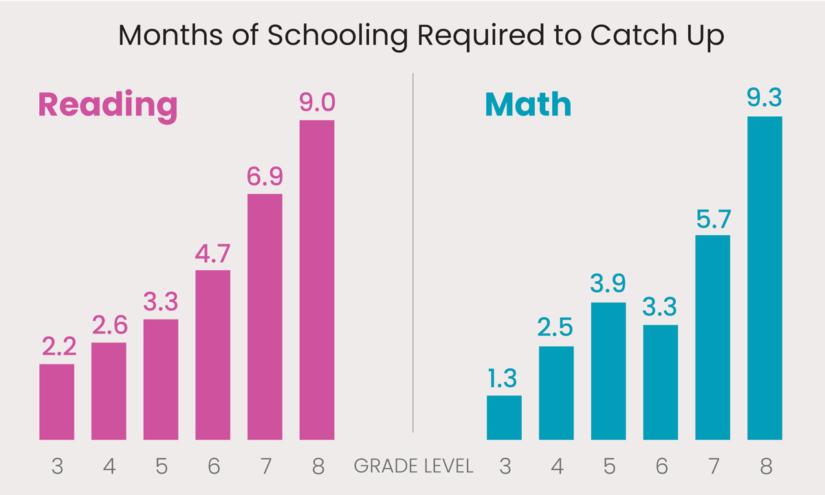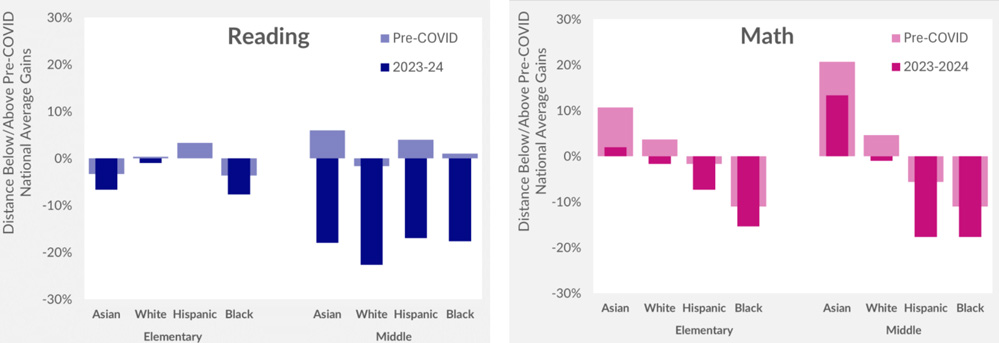Reflecting on the tenets that shape our educational practices is fundamental for …
Study finds that students going to high school are a year behind academically due to COVID.
Carlos Changemaker

Eighth-grade students continue to lag an entire school year behind pre-pandemic performance levels in both math and reading, as indicated by the latest test results. The data paints a grim picture of the ongoing impact of the COVID-19 pandemic, even after more than four years.
Recently unveiled, the statistics derived from over 7.7 million students who participated in the MAP Growth tests by NWEA reveal a worrisome pattern for incoming high school students this academic year. With many students starting fourth grade during the pandemic, the subsequent disruptions including a year of remote learning and issues of teacher shortages during the transition to middle school have compounded the challenges.
The 2023-24 results, which represent the final assessments before the exhaustion of federal COVID relief funds, highlight a critical juncture. With the obligation for districts to allocate any remaining funds by the end of September, the impending cutoff is anticipated to lead to further disturbances as schools are compelled to make adjustments in staffing and programs intended for academic recovery.
Researchers emphasize that older students face a slower pace of academic progress compared to their younger counterparts post-pandemic, necessitating greater effort to bridge the learning gap. Moreover, the repercussions of the disrupted learning environment persist for younger elementary school students who may have missed out on essential preschool experiences due to the pandemic. On average, students require an additional four months of schooling to catch up to pre-pandemic proficiency levels.
“It’s not fun to continue to bring this bad news to the education community, and I certainly wish it was a brighter story to tell,” expressed Karyn Lewis, the director of research and policy partnerships at NWEA. “It is pretty frustrating for us, and I’m sure very disheartening for folks on the ground that are still working very hard to help kids recover.”
Up to now, only California and Colorado have formally requested an extension to utilize the remaining diminishing relief funds, according to the U.S. Department of Education. This leaves most educational leaders grappling with the challenge of sustaining funding for extra tutorial support and staffing levels for students requiring remedial assistance, particularly those belonging to historically underserved groups.
The impact of the relief funds falls short of fully mitigating the learning setbacks, noted Dan Goldhaber, director of the Center for Analysis of Longitudinal Data in Education Research. Recent analysis authored by him underscored the limited impact of the recovery efforts tied to the federal dollars, partly due to the broad discretion provided to districts in spending the funds.
The requirement outlined in the American Rescue Plan mandating that 20% of the $122 billion allocation be channeled towards addressing learning loss was criticized for its vague implementation and lack of specific guidelines, according to Goldhaber.
Several districts that deployed teaching assistants to offer additional academic support to students in reading and math have now had to eliminate these positions. At Dothan Preparatory Academy in Alabama, staff members previously provided supplementary lessons based on MAP scores, a practice that has ceased with the disappearing positions.

The imminent opening of a new sixth-grade academy aims to better equip students with the requisite skills for grade-level coursework. Reflecting on the districtwide data assessment meeting he attended upon joining the Dothan City Schools, Longshore highlighted the pressing need to address the significant proficiency gaps observed across elementary schools.
“We’re trying to go backwards to go forwards,” Longshore remarked. “What third, fourth, and fifth-grade standards did you miss that are essential for your understanding of seventh and eighth-grade standards?”
Analysis from NWEA exposes widening achievement disparities among students. While some Asian students have demonstrated progress, their gains in math were lower last year compared to the pre-pandemic period. On the contrary, White, Black, and Hispanic students continue to face declining performance levels. The data confirms that Hispanic students in elementary and middle schools require the most additional instruction to reach pre-pandemic proficiency levels.

The reading proficiency gap has significantly widened by an average of 36% compared to pre-pandemic standards, surpassing the 18% increase observed in math. The emphasis on math recovery efforts may have inadvertently overshadowed the crucial need for enhanced reading skills essential for high school curricula.
Rebecca Kockler, leading the Reading Reimagined project under the nonprofit Advanced Education Research and Development Fund, highlighted the pressing need to address the persistent literacy challenges faced by older students. The project is funding research to identify effective literacy strategies tailored to adolescents, who often struggle with materials intended for younger age groups.
According to Kockler, the pandemic further exacerbated existing literacy issues among older students. She stated, “About 30% of American high schoolers have been proficient readers for 30 years, and that really hasn’t changed. It’s always the hardest to move middle school reading results, and even some of the success we would see in fourth grade didn’t always carry up into middle school.”
Students with learning disabilities bore the brunt of school closures, especially evident in the challenges faced by Tracy Compton’s daughters, both diagnosed with dyslexia. During their time at Fairfax County Public Schools in Virginia, the lack of services during the pandemic deprived them of crucial support in their reading development.
Under a federal civil rights agreement, the Fairfax district continues to provide compensatory services through private tutoring for the girls.
Compton emphasized the positive impact of relocating to a Massachusetts district where her daughters receive vital assistance, such as access to audiobooks and noise-canceling headphones during tests to enhance their focus. Despite progress made, she acknowledged that full recovery has not been achieved for her daughters.
Critical gaps in parental awareness regarding their children’s academic performance were highlighted by Compton. Many parents struggle to gauge their children’s proficiency levels, often misinterpreting report cards and overlooking standardized test results.
“They see the report card with A’s or whatever and think all is fine,” Compton remarked. “They don’t know where else to check and how to weigh things like standardized tests.”
Divergent narratives emerge through distinct testing methodologies utilized. Notably, the MAP test outcomes portray a bleaker picture compared to state-specific assessments, which primarily serve accountability purposes.
Despite some states reporting partial recovery and notable progress in specific indicators, the comprehensive student achievement spectrum captured by MAP tests underscores the broader challenges and disparities confronting students throughout the academic year.
Goldhaber stressed that low-income school districts, which received substantial funding allocations, must address the evolving learning needs of students post-federal relief funding cessation.
“How districts go about dealing with the fiscal cliff is going to have pretty significant consequences, particularly for the kids that were most impacted by the pandemic,” Goldhaber cautioned. The potential ramifications of staff layoffs, especially affecting newer teachers impacting the most vulnerable student populations, underscore the urgency of mitigating disruptions in academic support.
Looking ahead, Lewis underscored the imperative for school leaders to resist complacency and maintain vigilance in addressing academic disparities arising from the pandemic-induced disruptions.
“What keeps me up at night is this idea that these persistent achievement gaps are inevitable, that this is just how it’s going to be,” Lewis expressed. “I don’t think that’s the case, but I do think it takes innovation and creative thinking … to get us out of this mess.”



